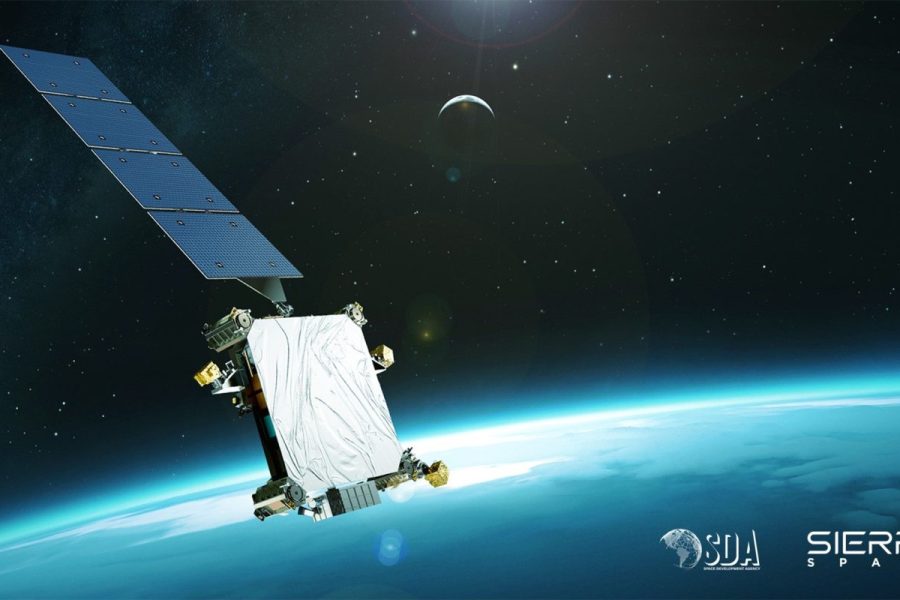The Space Development Agency awarded a combined $2.5 billion to L3Harris, Lockheed Martin, and Sierra Space for 54 satellites in its new missile warning/missile tracking (MW/MT) and missile defense constellation.
The buy—48 MW/MT satellites and six for missile defense sats—will be evenly distributed among the three suppliers, with each building 16 MW/MT satellites and two missile defense satellites for Tranche 2 of SDA’s Tracking Layer. The satellites, all in low-Earth orbit, will become part of the Space Force’s overall Proliferated Warfighter Space Architecture, a massive planned constellation of satellites.
The MW/MT satellites are designed to detect and track missile launches from space, using wide field-of-view infrared sensors. The missile defense satellites will have a mix of wide- and medium-field-of-view infrared sensors to generate high-quality fire control tracks to assist ground forces to intercept missiles, according to an SDA official.
Tranche 2 is set to launch no later than April 2027. It will expand the regional coverage offered by Tranche 1 into “global stereo coverage for missile warning/missile tracking,” the official said. “That’s multiple satellites looking at any point on the earth.”
SDA worked with the Missile Defense Agency to refine the requirements and technology for these satellites, the official added, pointing to MDA’s own Hypersonic and Ballistic Tracking Space Sensors program, two of which will launch alongside SDA satellites later this year.
“We’re looking to proliferate in future tranches, working with MDA so that we can get that fire control fidelity to support programs like Glide Phase Interceptor and other programs that could use that data to intercept threats,” the official said.
Both programs will work in concert with the Space Force’s existing Space-Based Infrared System, geosynchronous orbit satellites for missile warning.
“All of the assets that we have on orbit for missile warning/missile tracking are going to share their data to a shared network,” the official said. “Anyone who wants to get the data from SBIRS, from [medium-Earth orbit,] LEO, they will be able to get all of it. So it’ll be as seamless as possible to the warfighter.”
SDA plans a final constellation of about 100 MW/MT satellites in low-Earth orbit. Tranche 0, intended to demonstrate capabilities, but not for operational use, consists of eight spacecraft—four now on orbit, plus another four awaiting launch. Tranche 1, with 35 satellites, is slated to start launching in April 2025.
L3Harris was previously selected to build satellites for both the Tranche 0 and Tranche 1 Tracking Layers, and Lockheed Martin has won awards for all three tranches of the Transport Layer, which provides communications and data transmission. But Sierra Space is a new winner in SDA’s periodic competitions.
“We’re pleased to welcome Sierra Space, a new entrant as a prime vendor on Team SDA, as we continue working with L3Harris and Lockheed Martin on Tranche 2,” SDA director Derek Tournear said in a statement. “The marketplace is responding to the demand signals for our spiral development model. The agile response across the space industry is critically important as we deliver to the warfighter this no-fail mission capability of missile warning, missile tracking, and missile defense.”
SDA selected the three winners from among nine proposals, an official told reporters. The final contract awards were:
- $919 million for L3Harris
- $890 million for Lockheed Martin
- $740 million for Sierra Space
The official added that the average cost per MW/MT satellite will be $46 million, while the missile defense satellites will cost around $52 million each. In a release, Sierra Space noted that its deal includes a $20 million incentive for on-time delivery.
First, though, Congress needs to pass a budget, rather than keep the Pentagon operating under a continuing resolution as it has been since Oct. 1.
“We’re able to award these contracts and get started with kickoff and some initial milestones, but we certainly need a budget passed in March or earlier,” the SDA official said. “Otherwise we have to make some tough decisions and how we execute our programs.”
An SDA spokeswoman clarified that a continuing resolution, which keeps spending levels frozen at the previous year’s levels and prevents new programs from starting, could delay the timeline for the Tranche 2 Tracking Layer—an especially discouraging possibility given that Tournear has said the agency prioritizes speed in acquisition above all else.
SDA now has 417 satellites on contract, in addition to the 28 in Tranche 0 that are either in orbit or preparing to launch. The agency is pushing for an ambitious schedule of “spiral development,” with new tranches going up every two years and between 400 and 500 satellites constantly operational.
Such numbers would dramatically expand the Space Force’s fleet of satellites, which numbered 83 unclassified satellites as of Sept. 30, 2022.
Proliferated Warfighter Space Architecture
| TRANCHE | LAYER | # OF SATELLITES | CONTRACTORS |
|---|---|---|---|
| 0 | Transport | 20 | York Space Systems, Lockheed Martin |
| Tracking | 8 | SpaceX, L3Harris | |
| 1 | Transport | 126 | York Space Systems, Lockheed Martin, Northrop Grumman |
| Tracking | 35 | L3Harris, Northrop Gumman, Raytheon | |
| Demonstration and Experimentation System | 12 | York Space Systems | |
| 2 | Transport (Beta) | 90 | Northrop Grumman, Lockheed Martin, Rocket Lab |
| Transport (Alpha) | 100 | York Space Systems, Northrop Grumman | |
| Transport (Gamma) | 20 (approx.) | TBA | |
| Tracking | 54 | L3Harris, Lockheed Martin, Sierra Space | |
| Demonstration and Experimentation System | 20 (approx.) | TBA |
